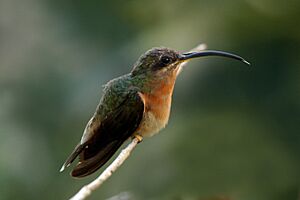Rufous-breasted hermit facts for kids
Quick facts for kids Rufous-breasted hermit |
|
|---|---|
 |
|
| G. h. insularum, Tobago | |
| Conservation status | |
| Scientific classification | |
| Genus: |
Glaucis
|
| Species: |
hirsutus
|
 |
|
| Synonyms | |
|
Glaucis hirsuta (Gmelin, 1788: lapsus) |
|
The rufous-breasted hermit or hairy hermit (Glaucis hirsutus) is a type of hummingbird. These tiny birds live and breed in areas from Panama down to Bolivia. You can also find them on the islands of Trinidad, Tobago, and Grenada. They are quite common in many places. However, their numbers can change in certain areas. Sometimes, they might even disappear from a specific habitat.
Contents
Meet the Rufous-breasted Hermit
The rufous-breasted hermit was first officially described in 1788. A German scientist named Johann Friedrich Gmelin gave it its scientific name, Trochilus hirsutus. This name was part of a big book about nature.
Today, this hummingbird is placed in a group called Glaucis. This group also includes two other species. The name Glaucis comes from an ancient Greek word meaning "blue-grey" or "pale green." The word hirsutus is Latin and means "hairy" or "bristled."
Different Types of Hermits
There are two main types, or subspecies, of the rufous-breasted hermit:
- G. h. insularum: These are found on the islands of Grenada, Trinidad, and Tobago.
- G. h. hirsutus: These live in Panama, western Colombia, Venezuela, the Guianas, Brazil, and northern Bolivia.
What Does a Rufous-breasted Hermit Look Like?
This hummingbird is about 10.7 centimeters (4.2 inches) long. It weighs around 7 grams (0.25 ounces), which is very light! Its beak is about 3.3 centimeters (1.3 inches) long. It is quite strong and curves downwards.
The rufous-breasted hermit has a brownish head. Its upper body is a shiny bronze-green color. Its belly and chest are a reddish-brown, or rufous, color. The tail feathers in the middle are green. The outer tail feathers are rufous with white tips. The top part of its beak is black, and the bottom part is yellow.
Males and females look very similar. However, males might have yellow streaks on the top part of their beak. Females might be a bit duller in color. A female's beak is also slightly shorter and more curved.
When this bird calls, it makes a high-pitched sound that sounds like "sweet."
How Rufous-breasted Hermits Live
These hummingbirds like to live in the lower parts of forests. You can often find them near streams or other running water. They mostly eat nectar from flowers. Nectar is a sweet liquid that plants make. They also eat some small insects.
What Rufous-breasted Hermits Eat
Rufous-breasted hermits are very picky eaters! They only visit flowers that have a shape and length that perfectly match their beak. Other hummingbirds are usually not as choosy. This means they get their food from many different kinds of flowering plants.
Some of their favorite plants are from the ginger family, like Costus scaber. They also like plants such as Heliconia standleyi and Heliconia stricta. Other plants they enjoy include Duroia hirsuta and Psychotria bahiensis. Even if a plant is very similar but has slightly different flowers, they will avoid it.
Scientists think that male and female hermits might visit different plants. This could be because their beaks are shaped a little differently. This helps them avoid competing for the same food. The hairy hermit is very important for pollinating some plants. This means they help these plants make seeds.
Reproduction and Nesting
Female rufous-breasted hermits lay two eggs. They build a small, cup-shaped nest. The nest is made of tiny roots and has a tail-like shape. They attach it to the underside of a palm leaf, fern, or Heliconia leaf. The nest is usually about one or two meters (3 to 6 feet) above the ground.
These nests are often found near streams, waterfalls, or roadsides. They are surprisingly easy to spot! The eggs hatch after about 17 days. The young birds are ready to leave the nest after 23 more days. A female hermit can nest up to four times in one season.
The male hummingbird helps to build and protect the nest. However, he does not sit on the eggs to keep them warm. In some areas, like Colombia, these birds can breed all year long.


